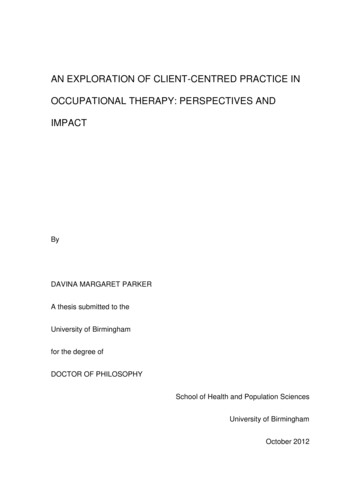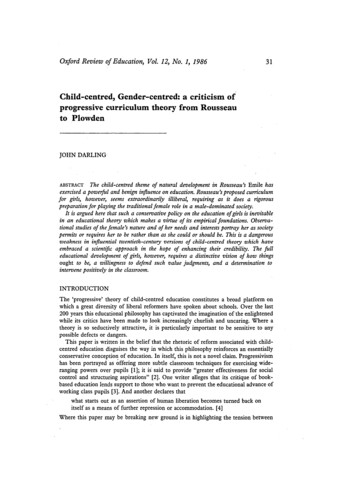
Transcription
AN EXPLORATION OF CLIENT-CENTRED PRACTICE INOCCUPATIONAL THERAPY: PERSPECTIVES ANDIMPACTByDAVINA MARGARET PARKERA thesis submitted to theUniversity of Birminghamfor the degree ofDOCTOR OF PHILOSOPHYSchool of Health and Population SciencesUniversity of BirminghamOctober 2012
University of Birmingham Research Archivee-theses repositoryThis unpublished thesis/dissertation is copyright of the author and/or thirdparties. The intellectual property rights of the author or third parties in respectof this work are as defined by The Copyright Designs and Patents Act 1988 oras modified by any successor legislation.Any use made of information contained in this thesis/dissertation must be inaccordance with that legislation and must be properly acknowledged. Furtherdistribution or reproduction in any format is prohibited without the permissionof the copyright holder.
ABSTRACTClient-centred practice underpins Occupational Therapy and is defined as apartnership between the client and therapist that empowers a client to fulfilhis/her occupational roles in a variety of environments. Given the importance ofthis approach, there has been limited exploration of what therapists and clientsexperience of this approach.A mixed method design examining the view of the clients and therapists wasundertaken using; a systematic review to examine worldwide evidence of a clientcentred outcomes measure, a survey of a sample of therapists’ experiences andindividual client and therapist interviews.Findings from this programme of work revealed that the clients’ perspective ofclient-centred practice was the value they placed on the attitude and behaviour ofthe therapist, communicating respect and treating them as equals. Therapistsvalued partnership but were challenged in establishing a relationship with theclient and failed to negotiate goals with them. Using a client-centred outcomesmeasure (the COPM) reinforced partnership, demonstrated joint goal setting andevaluated client satisfaction.Implications for practice; training needed in client-centred practice, theoreticalmodels, interviewing, risk assessment, goal negotiation and use of outcomemeasures. Communication, use of language and documentation should be clientcentred and reflect the client’s needs.
ACKNOWLEDGEMENTSCompletion of this research would not have been possible without thecontribution of the following people whom I wish to thank and acknowledge fortheir support.The clients of Worcestershire Care and Community Trust who gave their timeand shared their experiencesThe Occupational Therapists who shared their knowledge and practiceThe University Hospital Birmingham NHS Foundation Trust for financial supportMy Academic supervisors: – Dr Alistair Hewison, Prof. Collette Clifford, and DrSusan Corr for their guidance and criticism and for keeping me focusedDr Carol Dealey for her kindness and her time throughout the long period ofstudyDr Thelma Sumsion for her inspiration and encouragement to champion clientcentred practice in occupational therapyLastly and most importantly my family:My son Tom for his technical expertise and my husband Peter, for his enduringsupport over the years it has taken to complete my research, his patience and hisbelief in me.
TABLE OF CONTENTSCHAPTER 1: INTRODUCTIONBackground.1Defining Occupational Therapy.3Occupational Therapy and the NHS.10Client centred practice in the wider clinical context.11The political context.19Client- centred practice in Occupational Therapy.21Outcome measures.25Developing the research design.27Methodological approach.29Study 1.31Study 2.32Study 3.33CHAPTER 2: LITERATURE REVIEWIntroduction.36Rationale .37Search Strategy.38Core elements of client-centred practice.41Client- Centred Practice re-defined.48Impact on practice.52Professional Practice. 59
Clinical Practice.61The Client-Centred approach in practice.62Therapists’ perspective.66The Client perspective.69Conclusion.74Rationale for the research question.75CHAPTER 3: METHODOLOGYIntroduction.79Research Aim.80Philosophical framework.80Occupation.83Conceptual Models of practice.85Research design.88The Studies.94Conclusion.103CHAPTER 4:A SYSTEMATIC REVIEW OF THE CANADIAN OCCUPATIONALPERFORMANCE MEASURE:Introduction.104Description of the measure.105Rationale.107
Study framework.109Method.112Study design.117Results.123Study Findings.127Impact on practice.131Conclusion.138CHAPTER 5: THE THERAPISTS PERSPECTIVE OF CLIENT–CENTREDPRACTICE: A PROFESSIONAL VIEWThe Focus Group StudyIntroduction.140Rationale for the Focus Group.143Focus group methodology.144Focus group session. 146The Sample.150Data management 8
CHAPTER 6: THE THERAPISTS’ PERSPECTIVE OF CLIENT-CENTREDPRACTICE: A PROFESSIONAL VIEWThe Survey StudyIntroduction.181Literature 95Client centred practice.204The COPM.207Discussion.214Conclusion.219CHAPTER 7: THE INDIVIDUAL Findings.239Findings from Therapist Perspective.241Findings from the Client nclusion.265
CHAPTER 8: DISCUSSIONIntroduction.270Study 1: An international perspective.275Study 2: A professional perspective.276Study 3: The individual perspective.278Therapist Perspective.279Client Perspective.282Differences in perspective.284Limitations of the research.297Practice implications.301Personal reflections.306Conclusion.308CHAPTER 9: CONCLUSIONIntroduction.310Client-centred practice.312The Client.313The Therapist.314Recommendations.314Future research.316Bibliography.319 -349
LIST OF ILLUSTRATIONSFiguresNumberTitlePage Number1.1Thesis Design.302.1The Canadian Model of Occupational Performance.553.1Research overview.894.1Distribution of Respondents by grade.1964.2Range of Clinical specialties.1974.3Distribution of respondents’ current clinical area.1984.4Use of a Model of practice.1994.5Considered models of practice.2004.6Application of a frame of reference.2024.7Frames of reference in use.2034. 8Most important aspects of client centred practice.2054. 9Most difficult aspect of client centred practice. .2064.10Most rewarding aspects of client centred.2074.11Training methods on the COPM .2084.12Relevance of the COPM to practice.209
4.13What respondents think about using the COPM.2104.14Statements about the COPM.2114.15Use of the results from the COPM .2124.16How the results of the COPM are used.2137.1Theme Map.2618.1Inherent values and client-centred practice.279
LIST OF TABLESTableTitlePage number1.1The Core skills of Occupational Therapy.51.2Four models of the Physician – Patient relationship.162.1Features of models of practice in Occupational Therapy.544.1Search strategy.115 -64.2Hierarchy of evidence – quantitative studies.120-214.3Hierarchy of evidence – qualitative studies.1225.1Example of data analysis.1545.2Summary of Themes.1565.3Overarching themes.1577.1Therapist sample.2407.2Client Sample.2407.3Service Information. 2417.4Thematic analysis of the Therapist Interviews: Summary.2427.5Thematic analysis of the Clients Interviews: Summary.251-28.1Overview of the findings.274
Appendices:1.1BSc course in Occupational Therapy – Coventry & Derby1.2The Ottawa Charter2.1Literature review chart2.2CAOT permission for using the CMOP3.1University approval for Focus group4.1Methodological evaluation: PICO’s data extraction tool -sample4.2Systematic review – final sample4.3Systematic review – final sample clinical profiles4.4A Systematic review of the COPM5.1Focus group delegate letter5.2Focus group – data analysis6.1Thematic links across the research studies and the literature6.2Questionnaire6.3Invitation to take part in research -Therapist letter7.1Therapist interview guide7.2Client interview guide
7.3Participant information sheet - client7.4Participant Consent form - client7.5Letter to GP7.6Interview schedule (client and therapist) 1st draft7.7National Research Ethics Service approval7.8Sample of Client Interview transcript data analysis7.9Therapist Interviews - Analysis tool7.10Client Interviews - Analysis tool7.11Therapist Information sheet7.12Therapist consent form
AN EXPLORATION OF CLIENT-CENTRED PRACTICE INOCCUPATIONAL THERAPY: PERSPECTIVES AND IMPACTCHAPTER 1: INTRODUCTIONBackground:Client- centred practice provides the foundation for occupational therapy in manycountries, particularly in Canada and the United Kingdom (UK). It is frequentlyreferred to in core practice frameworks (Fearing & Clark 2000; Restall et al 2003) andmore importantly in respective codes of professional conduct (COT 2010a; CAOT2002). The professional body for occupational therapists in the UK, the College ofOccupational Therapists (COT), sets the benchmark for occupational therapypractice in the UK Code of Conduct by stating:“The College of Occupational Therapists is committed to client-centredpractice and the involvement of the service user as a partner in all stages of thetherapeutic process” (COT 2010a p.v)In addition the Code requires;“a continuing duty to respect and uphold the autonomy of service users,encouraging and enabling choice and partnership-working in the occupationaltherapy process” (COT 2010a p.9)and that therapists;1
“should work in partnership with the service user and their carer(s),throughout the care process, respecting their choices and wishes and acting in theservice user’s best interests at all times” (COT 2010a p.16).In the Code the term ‘service user’ refers to any individual in direct receipt of anyservices / interventions provided by a member of occupational therapy personnel.Knowledge of the theories and concepts of client-centred practice has grownconsiderably in the last two decades (Sumsion and Law 2006) and they have beenexplored in the professional literature (Law 1998; Sumsion and Law 2006; Townsend& Polatajko 2007; Fearing & Clark 2000). Despite this wealth of knowledge, mypersonal experience of managing an occupational therapy service and talking withclients, students and therapists suggested that this approach may not be widelyapplied in practice. This observation led me to question whether therapists were ableto practice in a client-centred manner and whether this could be determined usingavailable clinical outcome measures and most importantly, what did clientsunderstand about this approach and did it make a difference to their treatment? Thisconcern developed into a research question focused on understanding how clientcentred practice was evidenced in occupational therapy. In order to address thisquestion a research plan, which incorporated the therapist perspective, the clientperspective and the clinical outcome was developed. This involved a three studydesign which was iterative and interlinked to create a comprehensive programme ofwork.2
The research questionThe research question was:‘What are clients’ and the therapists’ perceptions of client-centred practice inoccupational therapy in the UK’?To understand the importance and influence of client- centred practice within theprofession of occupational therapy and its impact on practice, the therapist and theclient, the history and background to this way of working requires exploration. Thischapter will provide that context by considering the following key components: thehistory of the profession; the background and development of client centred practice;the relevance of outcome measures; and the part my own professional role had inquestioning the relevance of client-centred practice. Arising from this context theresearch design was developed to address the research question, examine practiceissues and explain the factors relevant to professional development, clinical practiceand future research.Defining Occupational Therapy:The profession of occupational therapy has acquired a multiplicity of definitionsduring the years since the first training school was opened in the UK in Bristol in1930. One of the earliest definitions by McNary in 1947 described it as;“any activity, mental or physical, medically prescribed and professionallyguided to aid a patient recover from disease or injury” (Hopkins 1993 p.3).The World Federation of Occupational Therapy (WFOT) lists 37 definitions whichhave been developed by national member organisations to reflect their practice3
(Duncan 2006). When Duncan (2006) reviewed these definitions he found that therewas a consensus regarding the core elements of Occupational Therapy (OT), namelythe connection of occupation with the therapeutic perspective. In 2010 the council ofWFOT published a ‘Statement on Occupational ) which affirmed for the memberorganisations, the scope, practice, education and focus of occupational therapyworldwide (WFOT 2010). The statement opens with;“Occupational Therapy is a client-centred health profession concerned withpromoting health and well being through occupation” (WFOT 2010 p4)In the UK, the Council of the COT acknowledged that defining occupational therapywas complex (Creek 2003) and adopted a shorter definition in January 2004 which islisted as the current COT UK definition on the World Federation of OccupationalTherapists website, it reads:“Occupational therapy enables people to achieve health, well being and lifesatisfaction through participation in occupation” (COT 2004 p1)This definition underpins the framework of this research with a focus on the coreskills of enablement through participation with occupation. Core skills are the expertskills shared by occupational therapists irrespective of their field or level of practice(see below). The College of Occupational Therapists (COT) in the UK defined theprofession’s core skills (Table 1.1) as built around occupation and activity whilstrecognising that these complex skills are composed of many component sub skillswhich include cognition and group leadership (COT 2009a).4
Table 1.1Core Skills of Occupational TherapyCore SkillDescriptorCollaboration withBuilding a collaborative relationship with the client thatthe clientwill promote reflection, autonomy and engagement in thetherapeutic processAssessmentassessing and observing functional potential, limitations,abilities and needs including the effects of physical andpsychosocial environmentsEnablementenabling people to explore, achieve and maintainbalance in their activities of daily living in the areas ofpersonal care, domestic, leisure and productive activitiesProblem solvingidentifying and solving occupational performanceproblemsUsing activity as ausing activities to promote health, well being and functiontherapeutic toolby analysing, selecting, synthesising, adapting, grading,and applying activities for specific therapeutic purposesgroup workplanning, organising and leading activity groupsEnvironmentalanalysing and adapting environments to increaseadaptationfunction and social participationCreek 2003 p365
The focus of occupational therapy practice, which appears deceptively simple, is thedoing of everyday activities or occupations; its complexity is in understanding thefactors that influence and shape these activities by constructing interventions whichenable the client to achieve mutually agreed goals. Duncan (2006) explained that thekey skill of the occupational therapist is to bring an occupational perspective to thetherapeutic context, taking into account a person’s ability and identity. Occupationaltherapists work with clients’ strengths and address areas of occupational dysfunction,in other words activities of everyday living with which the client struggles as a resultof illness, disease or trauma. Occupational therapists work with all age groups acrossa variety of settings for example; physical and mental health hospitals andcommunities, prisons, rehabilitation units, private health and the voluntary sector anddeal with a wide range of social, medical and environmental problems. The skill ofthe occupational therapist lies in the accurate assessment of a person’s abilities anddeficits and the construction of a planned graduated intervention plan, using activityor occupation to remediate function and increase independence. Key to thisapproach is the use of occupation or activity and the centrality of the individual withinthe therapeutic context (Duncan 2006).Historical roots of Occupational Therapy:Appreciating the history of occupational therapy adds to an understanding of currentapproaches and theories which influence how occupational therapy practice hasbeen shaped. The title of the profession links the practice directly to occupation. Thehistorical basis for health through occupation can be traced back to the OldTestament. In 30 B.C. Seneca recommended employment as a treatment for mentalagitation and in the classical period of the Ancient Greeks and Romans, the remedial6
and health promotional effects of occupation were noted as essential to humanhappiness (Haworth & McDonald 1946). Occupation has been central to humanexistence throughout time and remains pivotal today in terms of health and wellbeing, with lack of health reducing the ability of the individual to engage in occupation(Reed 1993). During the 19th century the issues of health and occupation wereexplored in many writings in English society, but those which had the greatestinfluence on occupational therapy were related to the philosophy of humanism andthe social values of humanitarianism, which were also the basis of the moraltreatment and the arts and crafts movements (Reed 1993).The moral treatment movement was the vision of the Quaker, William Tuke, (Tuke1813 cited by Borthwick et al 2001) who founded the York Retreat in England in1796. This movement set out to treat patients with mental illness using work andoccupation rather than confinement. It was a humane revolution that had a huge andlasting influence on the practice of psychiatry as it aimed to provide acompassionate, homely environment for people afflicted by loss of reason (Reed1993). Based on the Quaker principles of spiritual equality for all human beings andwith an emphasis on creating an environment which encouraged the individual totake personal and social responsibility, the moral treatment movement recognisedthe importance of useful occupation as a form of treatment contributing to themaintenance of health (McDonald et al 1972).This principle is also at the heart of thepatient-centred philosophy which is central to occupational therapy today (Duncan2011).The arts and crafts movement, spearheaded by John Ruskin the English philosopherand William Morris an artist and architect (Reed 1993), emerged in the latter half of7
the 19th century. This movement, when translated into education and therapyprovided two approaches; one approach became known as diversional therapy andthe other as occupational training. The former became dominant in occupationaltherapy practice in psychiatry whilst the latter was prevalent in occupational therapypractice for people with physical disabilities (Reed 1993).Modern day Occupational Therapy:Occupational therapy as it is known today was formally recognised in 1917 with theestablishment of the National Society for the Promotion of Occupational Therapy inthe USA. Prior to that, programmes of occupation are known to have been inexistence in the early part of the twentieth century (Haworth & McDonald 1946). Agroup of professionals from a broad range of backgrounds founded the NationalSociety, an organisation which later became the American Occupational TherapyAssociation and was influential in the development of the profession (Duncan 2006).However one individual who had a significant impact on the development ofoccupational therapy was Dr Adolph Meyer (1886 -1950), who was born inSwitzerland but spent his professional career in America, eventually becoming theDirector of the Johns Hopkins University Medical School. During his career Meyerrecognised the importance of instincts, habits, interests and experiences in people’slives. Consequently he developed an interest in the impact occupation had on hispatients and employed Eleanor Clark-Slagle (a founder member of the NationalSociety), who had trained in occupational therapy, to work with him. Meyer presentedthe first organised model of occupational therapy in 1921 in a lecture ‘The philosophyof occupational therapy’ (Reed 1993 p29). Even at this very early stage in thedevelopment of the profession, the core themes of occupation, a sense of doing and8
the relationship with the client were evident. Meyer described human organisation ashaving a particular rhythm of work, play, rest and sleep which needed balancing(Meyer 1922). He believed the only way of achieving this balance was by ‘actualdoing and actual practice’ (Meyer 1922 p6) recognising the value to the individual ofoccupation and the satisfaction of achievement and completion of work activities. Healso acknowledged the individuality of the therapists, noting that resourcefulness anda respect for the client’s capacities and interests contributed to the client’s sense ofachievement.The work of Meyer and Slagle influenced others to establish occupational therapydepartments and the first in the UK was at the Gartnavel Royal Hospital whichopened in Glasgow in 19
Client-centred practice underpins Occupational Therapy and is defined as a partnership between the client and therapist that empowers a client to fulfil his/her occupational roles in a variety of environments. Given the importance of this approach, there has been limited exploration of










